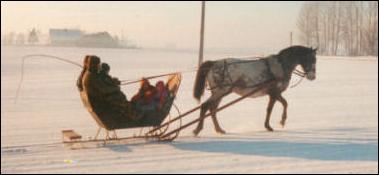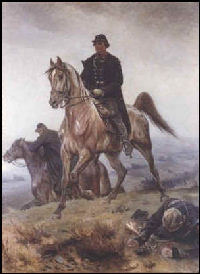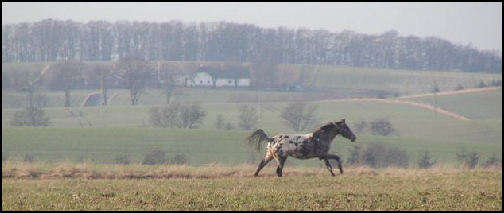 |
 |
 |
Home | Knabstrupper history and colour | Stallions | Broodmares | Our Horses | Foals | Horses for sale | Links | Contact us | News | Site map|
Knabstrupper History |
||
 |
The Knabstrupper is a colourful Danish warmblood breed a form of which has existed in Denmark since 1671. In 1812 a Frederiksborg, whose pedigree dated back to the late 17th Century, covered the unusually coloured Flaebe mare. It can be assumed that this mare carried the leopard complex gene which was expressed on her as a blanket with snowflake and spotted patterning which she passed on to her offspring. Flaebe had been aquired by Major Villars Lunn at the Knabstrup Hovedgaard estate and his decision to breed her to the Frederiksborg stallion resulted in the Knabstrupper breed being born. Knabstruppers were known for their stamina and intelligence and became very popular warhorses for the officers. |
|
The breed flourished but a fire at the Knabstrup stable in 1890 resulted in almost all the breeding stock being lost. In 1931 the Association for Preservation of the Knabstrupper breed was started to be followed by the Knabstrupper Association of Holbaek county formed in 1949. This organisation went nationwide in 1971 as the Knabstrupper Foreningen for Danmark and is the organisation that exists today. For a more detailed history of the Knabstrupper please go to the KNN history page. |
 |
|
| Knabstrupper Colour | ||
The coat patterns of the Knabstrupper are a product of the Leopard complex gene (Lp) which is dominantly inherited. This gene is present in other breeds most notably the Appaloosa and acts in the same way no matter which breed of horse it is present in. The Lp gene produces three characteristics in a horse: mottled skin, striped hooves and white schelra also known as the human eye. These characteristics can appear on horses without the Lp gene but it is highly unlikely to find all three in a non Lp carrying horse. The effect of the Lp gene on a horse's coat is basically a command to be white. The gene is a complex gene and works with a group of modifiers called pattern genes. There may be up to thirty of these pattern genes and it is not known exactly how these genes work. It may be that all horses carry some form of the pattern genes. The level of pattern on a horse is also affected by the horse's base coat colour e.g. black, chestnut, bay etc. Although all Knabstruppers have a unique coat pattern there are basic patterns which range from top to toe leopard to just a little roaning out and of course there are solid coloured horses. It should also be noted that the Lp gene always carries the roaning effect, not to be confused with the roan gene seen on non Lp carrying horses, but the level of roaning produced may vary from a few hairs to outright body roaning. Horses born with two Lp genes are called fewspot or whiteborn. They are homozygous for Lp and will always pass on the Lp gene. The level to which they pass their colour/ pattern on is dependant on the pattern genes they pass on to interact with the Lp gene. These homozygous horses can range from pure white to just having a few white hairs and will usually only have a few spots or none at all. They also usually have white hooves which helps to identify them. For a horse to be homozygous for Lp both of its parents must have been carrying at least one Lp gene. Those horses with one Lp gene i.e. heterozygous will pass on Lp 50% of the time when crossed with solid coloured non Lp carrying horses and 75% of the time when crossed with another heterozygous Lp carrying horse. It must be remembered that each mating to a heterozygous Lp carrying stallion will be subject to these statistics and although some stallions may have produced as much as 80% or as few as 20% Lp carrying offspring to date the odds are reset at each individual mating. The Lp gene and its effects is a complicated subject and this is just a very simple outline of it. |
||
 |
||